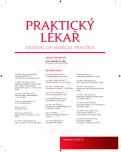-
Medical journals
- Career
Life style analysis of yoga exercisers in comparison with the general population
Authors: V. Čajka; E. Sovová 1; D. Pastucha 2; I. Benušová 2; P. Dupalová 2; E. Kudlová 2; K. Langová 3; D. Horáková 4; J. Zapletalová 4 5
Authors‘ workplace: Ordinace praktického lékaře, Nový Malín 1; Fakultní nemocnice OlomoucKlinika tělovýchovného lékařství a kardiovaskulární rehabilitacePřednostka: doc. MUDr. Eliška Sovová, Ph. D., MBA 2; 1. lékařská fakulta Univerzity Karlovy, PrahaÚstav hygieny a epidemiologiePřednosta: doc. MUDr. Milan Tuček, CSc. 3; Lékařská fakulta Univerzity Palackého, OlomoucÚstav preventivního lékařstvíPřednostka: doc. MUDr. Helena Kollárová, Ph. D. 4; Lékařská fakulta Univerzity Palackého, OlomoucÚstav lékařské biofyzikyPřednostka: prof. RNDr. Hana Kolářová, CSc. 5
Published in: Prakt. Lék. 2013; 93(6): 260-263
Category: Of different specialties
Overview
Introduction.
Poor dietary and lifestyle habits significantly contribute to the risk factors of cardiovascular disease. The aim of this study was to survey the dietary and lifestyle habits associated with the risk factors in persons practicing yoga and compare them with those of the general population.Subjects and methods.
This study consisted of two groups - yoga and general population (GP). The yoga group included 58 persons (17 males and 41 females, aged 26–68 years) who had been practicing yoga daily for at least two years according to the system of Yoga in Daily Life. The general population group included individuals who were selected from a General Practitioner’s surgery in Novy Malin in the Czech Republic to match the yoga group in age and sex. All subjects filled out a questionnaire regarding their dietary and lifestyle habits. The answers from both sample groups were analysed using a two-sample t-test and a Shapiro-Wilk test.Results.
The Yoga group had significantly lower (p < 0.0001) BMI, consumption of red meat, white meat, fish, sausage, entrails, lard, eggs, white flour dumplings, canned and fried food, and coffee, as well as number of smokers and former smokers. The yoga group also had lower consumption of alcohol (p = 0.016). The yoga group had significantly higher (p < 0.0001) consumption of vegetables and exercised significantly more than the control group. The yoga group also had higher consumption of vegetables (p = 0.009) and whole grain bread (p = 0.014).Conclusion.
Lifestyle and die-tary habits in persons who practice yoga daily contribute to lower risk factors of cardiovascular diseases.Keywords:
lifestyle – diet – dietary habits – yoga – prevention
Sources
1. Innes KE, Bourguignon C, Pylor AG, et al. Risk indices associated with the insulin resistance syndrome, cardiovascular disease, and possible protection with yoga: a systematic review. J Am Board Fam Med 2005; 18(6): 491–519.
2. Innes KE, Vincent HK. The influence of yoga-based programs on risk profiles in adults with type 2 diabetes mellitus: a systematic review. Evid Based Complement Alternat Med 2007; 4(4): 469–486.
3. Gordon LA, Morrison EY, McGrowner DA, et al. Effect of exercise therapy on lipid profile and oxidative stress indicators in patients with type 2 diabetes. BMC Complement Altern Med 2008; 13 : 8–21.
4. Streeter CC, Whitfield WH, Owen L, et al. Effects of yoga versus walking on mood, anxiety, and brain gaba levels: a randomized controlled mrs study. J Altern Complement Med 2010; 16(11): 1145.
5. Maheshvarananda PS. Systém Jóga v denním životě. Vienna: Ibera Verlag/EUP 2000.
6. Kudlová E, Slámová A. Analýza životního stylu seniorů žijících v domácím prostředí se zaměřením na stravovací návyky. Prakt. Lék. 2006; 86(8): 439–442.
7. Sovová E, Kaletová M, Nakládalová M, et al. Vliv cílené intervence na výskyt rizikových faktorů kardiovaskulárních onemocnění u zdravotnických zaměstnanců. Vnitř. Lék. 2006; 5 : 21–25.
8. Gokal R, Shillito L, Maharaj SR. Positive impact of yoga and pranayam on obesity, hypertension, blood sugar and cholesterol: a pilot assesment. J Altern Complement Med 2007; 13(10): 1056–1058.
9. Kosuri M, Sridhar GR. Yoga practice in diabetes improves physical and psychological outcomes. Metabolic Syndrome and Related Disorders 2009; 7(6): 515–518.
10. McIver S, O’Halloran JP, McGartland M. The impact of hatha yoga on smoking behavior. Altern Ther Health Med 2004; 10(2): 22–23.
11. Sharma M, Corbin DE. A preliminary study of the effects of an innovative social cognitive theory – driven, yoga – based behavioral intervention on smoking cessation. Californian Journal of Health Promotion 2006; 4(4): 63–76.
Labels
General practitioner for children and adolescents General practitioner for adults
Article was published inGeneral Practitioner

2013 Issue 6-
All articles in this issue
- Neurobiology of adolescence
- ECG in athletes: new „Seattle criteria“
- WikiLectures: On-line educational materials for studies and clinical practice
- Life style analysis of yoga exercisers in comparison with the general population
- Violence in health care
- Cognitive rehabilitation in patients with mild cognitive impairment and dementia in conditions of daily out-patient unit – pilot study
- Personage and writings of Aulus Cornelius Celsus
- General Practitioner
- Journal archive
- Current issue
- Online only
- About the journal
Most read in this issue- Neurobiology of adolescence
- ECG in athletes: new „Seattle criteria“
- Cognitive rehabilitation in patients with mild cognitive impairment and dementia in conditions of daily out-patient unit – pilot study
- Violence in health care
Login#ADS_BOTTOM_SCRIPTS#Forgotten passwordEnter the email address that you registered with. We will send you instructions on how to set a new password.
- Career

